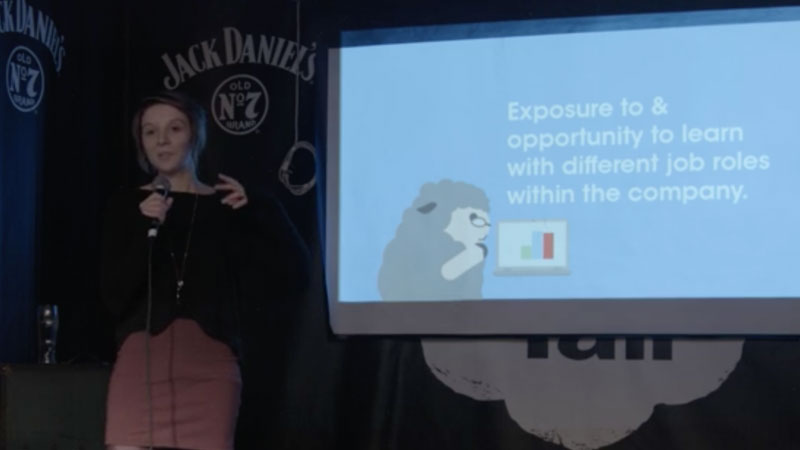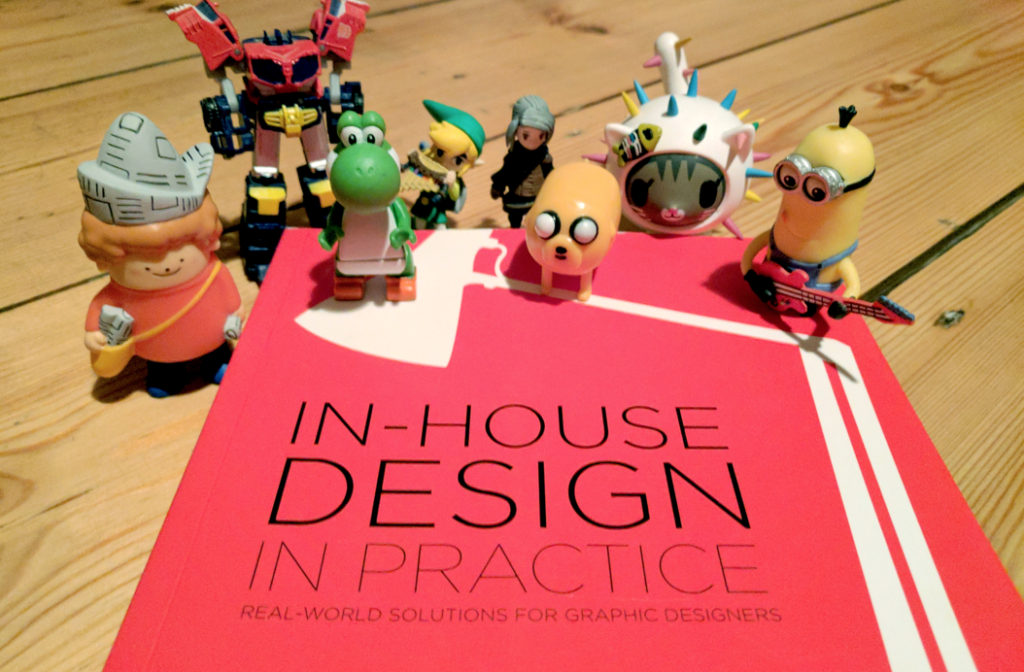Revisiting: ‘In-house design is not a dirty word’

I’ve spoken about in-house design publicly three times, at three events at quite different time in my life/career.
The first was at Reasons to be Creative conference in Brighton as one of the elevator pitchers. The second was the same talk, extended into 20 minutes and given at Design Stuff Cardiff (This talk uses my old birth name not my chosen name) and the third time was this year in 2017 at South West: UX.
Prior to speaking at them, I was attending these conferences and meet-ups early on in my design career and hearing addresses from designers and developers in agency or freelance careers but was keen to talk to more people who were on a similar path as me or had walked it before.
“Where are all my fellow in-house designers?” I’d think, at these events. I was here and I worked with at least 3 others, as well as knowing multiple in my city so why weren’t they on stage talking about the industry?
So I did the talking it instead of waiting…
The underlying focus of the talks I then gave was that in-house design could be talked about in the same way that other design pathways were.
There was a perception both from non-in-housers that in-house designers are less creative, less worthy of note or worked on projects or with brands that ‘didn’t excite other designers’. This perception I found, was then also internalised by in-house designers.
This perception is a damaging one, for the wider industry but especially for those still in design education, where In-house as a viable career option isn’t being given the same spotlight as freelance or agency.
Some of my previous talking points ring true and I wanted to revisit them with some more years of experience under my belt as well as years for the design industry to evolve and flex.
I’ll often refer to the companies that in-house designers work in as ‘corporates’ for ease of the text. Not all in-house designers work in what would be described as ‘corporates’ though as some may work in third-sector organisations, charities or other types of organisation.
Original point: “When a new campaign is planned, you’ll often get to work on every aspect from web and digital to app and mobile to above the line and print right up until launch and beyond”
Revised point: Only really applicable in companies that don’t have specialisations and much more prevalent when in-house designers were required to be multi-skilled. You see much more specialisation roles with in-house now, especially in larger corporates. Still true in your start-ups, smaller corporates and companies with a culture that supports cross-discipline work/collaboration.
Original point: “You work with not just other creatives, but front and back end developers, product managers, PPC & SEO, Marketing, HR and so on. This can broaden your general related business knowledge and knowing what each teams goals are can help you better design for that area.”
Revised point: Again, more applicable in larger in-house companies and some multi-discipline agencies. The difference here is that with the in-house corporates, the other folk you work with tend to be your ‘stakeholders’ or ‘internal clients’ as well as (or some times rather than) your colleagues. So for example, you could be producing a piece of design work for the SEO team rather than with the SEO team.
Original point: “You’re often called upon to plug related skill gaps. A personal example is that I was asked to do production photography for a recent advert shoot. Something which I’ve never done before.”
Revised point: I believe this to be true of both in-house, freelance and agency designers. Some corporates will ‘require’ this of their designers more so than agencies perhaps, and some corporates will be looking mostly at the savings on bringing in extra contract/agency resource for these skills gaps. Still, I do think there are corporates out there that promote this as the benefit it can be to designers goals. Like if in the example above a designer primarily involved in Digital Design who wants to develop their photography skills, then this skill gap fills both a business need and a personal development need for the designer.
Original point: “Depending on the sector, you can have incredible job stability, a generous training budget and build lots of different skills by learning from colleagues.”
Revised point: You’re still beholden to the whims of business. If the corporate isn’t doing well you’ll be just as likely to be let go as in an agency who didn’t retain a client. There’s perhaps a sense of being further removed from the finance side of things which can be more comforting and your ‘selling in’ is to stakeholders within the business as opposed to clients who directly hold cash.
I’ve also heard from both in-house and agency side the ‘We haven’t got time/budget/other reason’ for training new skills or diversifying existing ones. I think this is an individual business and personal advocacy thing rather than a in-house/agency thing.
Original point: “You meet agencies from the other side of the table when outsourcing particular work. This can give you greater understanding of client thought process and rational which can help if you do freelance on the side or are looking to move into an agency.
Revised point: You do have this in corporate (as long as it makes financial sense for the corporate). Though I do believe some agencies hire other agencies and contractors to plug skills gaps so there’s some sense of what this dynamic is like in both work styles. It’s probably the instance that still needs the most work from both agency and in-house (and beyond). There are ways that this relationship can be made much easier, inclusive and frictionless but the knee-jerk reaction is to segregate in-house designer and agency designers when working on the same project/for the same company. The competitive edge that in-housers can get is they can potentially speak ‘in-house/corporate’ language well and that is a benefit moving into an agency/freelance environment.
Original point: “Because you work with one brand and sub-brands. You become an expert in it and are incredibly valued. It also exercises your skills to keep creative interesting, relevant and up-to-date.”
Revised point: You really do. You know that brand inside out and back to front (if you stay in the corporate long enough) and really, even the smallest single brand is so far reaching that you’ll always be learning new things. One thing I struggled with agency/freelance side was sometimes you put down projects/brands that you’ll never pick back up again (through no fault of your own). The part of me that wants to follow-up, iterate, improve and learn struggles with this the most. The downside is: Attachment. Oh I became attached to some of my previous brands/companies which made it harder to move on to new places without still being invested in what was happening back in the old pasture…
Original point: “You can be approached with jobs that need completing within days or even hours and little space to say no because you’re there to solve creative problems for the business.”
Revised point: It’s very hard to say no to these in-house (unless you are the boss of course). But within my agency/freelance capacity I’ve felt more empowered to say ‘no’ to work that is far too last minute and make that choice to not get paid. That being said, I’ve experienced a similar amount of ‘crunch’ working corporate/agency/freelance. Again, I think this is an ‘industry’ or ‘inherent value of creative work problem’ rather than isolated to a particular work style. The real differentiator here is whether or not you have a team around you to support any last-minute work/changes or whether you’re solo.
Original point: “When you’re helping others around the business, they’ll love you and when your pushing back you can get frowns. Either way you’ll get regular desk visits and very little ‘me’ time.”
Revised point: This is both a in-house thing but also a business-culture thing. Designers and creative tend to be approachable folk as part of their job is to communicate why design matters to the business and individuals. What this comment really alludes to is that because you are typically exposed to more types of roles in-house (HR, PR, Marketing, Sales, Development etc.) you’ll be asked to do some things that are not strictly part of your job. My favourite include: Branded pillows as a marketing giveaway, A first aider poster to put up in the company kitchen and Decorating the office for various festive events.
Original point: “Working with one brand can get dull and repetitive. Extracurricular activities are a must.”
Revised point: But so can working on one client for a long period of time. Also I found it more frustrating being involved on some parts of a client project and not others so there are frustrations either side and depends on individuals. Anyways, at the point where working on ‘one brand’ gets dull is a good time to be analysing what automation and patterns are built into the current projects to mitigate that repetition (potential wasted time).
So, there are some things that are still prevalent with in-house design roles but most joys and frustrations are shared across the spread of roles, companies, cultures, work-styles and set-ups.
But really, what I’m asking here is:
More diverse roles and backgrounds in speakers at design conferences.
Better communication, support and sharing across disciplines and work places.
Concentrated effort to not ‘other’ a certain kind of job role or work place.
[
In-house design practice by Cathy Fishel is a great book on In-house design